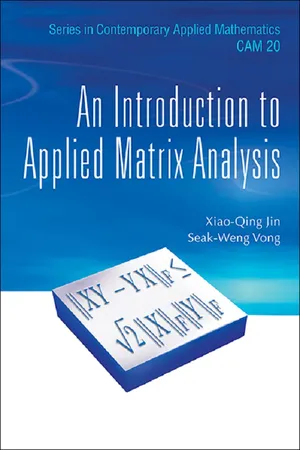
An Introduction to Applied Matrix Analysis
Xiao Qing Jin, Seak-Weng Vong
- 144 pages
- English
- ePUB (adapté aux mobiles)
- Disponible sur iOS et Android
An Introduction to Applied Matrix Analysis
Xiao Qing Jin, Seak-Weng Vong
À propos de ce livre
It is well known that most problems in science and engineering eventually progress into matrix problems. This book gives an elementary introduction to applied matrix theory and it also includes some new results obtained in recent years.
The book consists of eight chapters. It includes perturbation and error analysis; the conjugate gradient method for solving linear systems; preconditioning techniques; and least squares algorithms based on orthogonal transformations, etc. The last two chapters include some latest development in the area. In Chap. 7, we construct optimal preconditioners for functions of matrices. More precisely, let f be a function of matrices. Given a matrix A, there are two choices of constructing optimal preconditioners for f ( A ). Properties of these preconditioners are studied for different functions. In Chap. 8, we study the Bottcher–Wenzel conjecture and discuss related problems.
This is a textbook for senior undergraduate or junior graduate students majoring in science and engineering. The material is accessible to students who, in various disciplines, have basic linear algebra, calculus, numerical analysis, and computing knowledge. The book is also useful to researchers in computational science who are interested in applied matrix theory.
Contents:
- Introduction and Review
- Norms and Perturbation Analysis
- Least Squares Problems
- Generalized Inverses
- Conjugate Gradient Method
- Optimal and Superoptimal Preconditioners
- Optimal Preconditioners for Functions of Matrices
- Böttcher–Wenzel Conjecture and Related Problems
Readership: Undergraduate students in linear and multilinear algebra/matrix theory, and numerical analysis.
Key Features:
- The preconditioning techniques proposed in Chapter 7 for matrix functions and an elementary proof of the Bottcher and Wenzel conjecture with related problems in Chapter 8 should be interesting to readers because they appear for the first time in a textbook
Foire aux questions
Informations
Chapter 1
Introduction and Review
1.1Basic symbols








